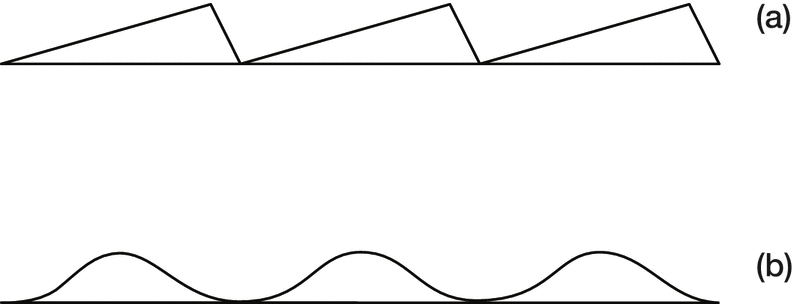The interaction of radiation with matter possessing a regular periodic structure at or near the same size as the wavelength of the radiation will exhibit diffraction. For example, diffraction is well-known in x-ray crystallography, in which a beam of x-rays incident on a crystalline sample diffracts due to the regular placement of molecules in the crystal. A more common example of diffraction is the variety of colors seen from the surface of a compact disc.
A diffraction grating can be thought of as a collection of narrow slits. Multiple slit interference can then be used to model the effects of a grating on incident light. Light of a single wavelength passing through the grating (or reflected from the grating) is diffracted by the grooves; in most directions the light diffracted from one groove cancels from that diffracted from other grooves through destructive interference. In a certain finite number of directions, though, all of the rays from the grooves interference constructively. Such directions correspond to diffraction orders. Many orders exists when the wavelength of the light diffracted is much smaller than the distance between adjacent grooves; few order exists when this wavelength is comparable to the groove spacing, and no orders exists except the reflected ray when the wavelength exceeds two times the groove spacing (in the last case the grating behaves as a mirror).
Gratings are found in most light spectrometers, covering the UV, visible and infrared spectra. Absorption and emission spectrometers, fluorometers, inductively-coupled plasma (ICP) instruments, and high-performance liquid chromatography (HPLC) equipment all use grating spectrometers. Large research spectrometers, such as those that analyze very short wavelength light (i.e., extreme UV and x-ray light) from synchrotron radiation beamlines, also use gratings. Large gratings are used in astronomical telescopes to allow light from objects in space to be analyzed spectroscopically. Gratings are also used for tuning lasers and for compressing and stretching laser pulses.
Not all spectrometers use gratings; mass spectrometry, for example, disperses matter by velocity rather than radiation by wavelength, and Fourier transform infrared (FTIR) spectrometers accomplish wavelength differentiation using an interferometer rather than a monochromator.
Commercial surface-relief gratings are produced using an epoxy casting process called replication; in essence, this process involves pouring a liquid into a mold, allowing the liquid to harden, and then removing the hardened material from the mold without damaging either. The replication process yields optically identical copies of the original grating, called the master grating.
The vast majority of master gratings are formed in one of two ways: by mechanical ruling, in which a diamond is dragged across a metallized substrate to produce a series of parallel grooves, or by interference methods, in which the fringe pattern formed by two coincident laser beams exposed a photosensitive blank, creating all grooves at once. The latter method produces gratings commonly termed "holographic". Since making one high-quality master grating can take weeks, without a replication process grating-based spectrometers would not be commercially available.
The surface corrugation of a grating is usually one of two types. A sinusoidal profile (Figure 2a) is characteristic of many holographic gratings. A triangular "staircase" profile (Figure 2b) is commonly created by mechanical ruling. The triangular profile can generally be designed to diffract more light into a particular order (for a given range of wavelengths) than a sinusoidal profile can; as a result, gratings with triangular groove profiles are universally called blazed gratings (due to the brightness of their spectra). Replication preserves the profile of the master grating faithful throughout the family of replicas made from it, so their optical performance matches that of the master.
 Over 8,000 products in-stock! & FREE 2-Day shipping on all web orders!* Learn More FREE T-Shirt with orders $250+ Details
Over 8,000 products in-stock! & FREE 2-Day shipping on all web orders!* Learn More FREE T-Shirt with orders $250+ Details

 Ultra-High Velocity
Ultra-High Velocity